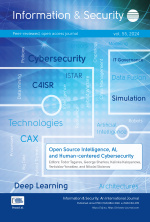CROCADILE - An Open, Extensible Agent-Based Distillation Engine
Source:
Information & Security: An International Journal,Keywords:
2D simulation engine, 3D simulation engine, Conceptual Research Oriented Combat Agent Distillation Implemented in the Littoral Environment, CROCADILE, multi-agent based distillation system, projectile or probabilistic hit resolutionAbstract:
This paper describes a new multi-agent based distillation system known as CROCADILE – Conceptual Research Oriented Combat Agent Distillation Implemented in the Littoral Environment. CROCADILE shares the common features of other distillations such as MANA or EINSTein – an abstracted representation of the capabilities and behaviour of the conflict participants, from the interactions of those participants combat behaviour is seen to emerge. CROCADILE extends the realm of distillation systems in a number of novel and powerful ways delivering an open, extensible distillation engine realised in a 3D world and with variable levels of fidelity. In particular some of the key aspects that differentiate CROCADILE are: a 3D or 2D simulation engine; projectile or probabilistic hit resolution; units that can move by land, sea or air; support for multiple agent behaviour paradigms and user written agents; a high fidelity combat model that incorporates indirect fire, line of sight, round penetration and burst effects; sophisticated configurable command, mission, communication, and team structures; comprehensive logging of simulation results; and a database system for saving and loading world objects. CROCADILE follows an object-oriented approach in its design and realisation at all levels, making it easily extensible. Written in the Java language it is platform independent and freely available. The paper first covers the design philosophy and implementation of CROCADILE. A scenario concerning a potential future force structure for the Australian Army is then employed as a means of illustrating some of the features of the system. A number of runs of the system for the given scenario are analysed as to outcome for the teams of agents, weapon effectiveness, and the distribution of hits, damage and agent deaths within the physical combat space.
